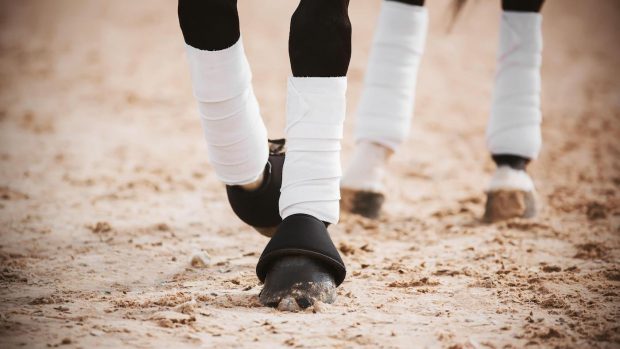All horse owners should know how to put on a tail bandage correctly. The tail bandage has traditionally been used to protect the tail and dock while in transit and to help keep a pulled tail looking smart. However, there are also tail guards and other protectors now available.
Products such as Velcro-fastened neoprene tailguards are easy to apply, easy to remove and easy to wash making them preferable to many horse owners, while the “old school” remains faithful to the traditional elasticated bandage.
Elasticated tail bandages need to be carefully applied to ensure they remain in place, and bandaging is a skill that is only acquired through plenty of practice.
A tail bandage which is too loose will fall off and could get tangled in the horse’s legs, while an over-tight bandage could cause permanent damage to the tail. Tail bandages should not be left on for long periods, no longer than three hours.
Repeated use of an over-tight bandage may cause white hairs to appear in a dark coloured tail, damage to the underside of the dock, or in extreme cases, cause the tail hair to fall out.
An over-tight bandage can also cause an extreme “colic-like” reaction from the horse or pony, especially from those who have not worn a tail bandage before. Leaping around, rolling, sweating and bucking can all be caused by an incorrectly applied tail bandage. Remove the tail bandage and normality will be restored.
The old adage of “if in doubt, go without” is sound advice – if you are not proficient at doing a tail bandage, keep practising under a knowledgable eye until you have perfected the skill. A slightly rubbed tail can normally be brushed down at a show/hunt etc with a little water, although horses which really “sit back” and damage their tail when being travelled may need additional protection.
How to put on a tail bandage
- Make sure the horse is relaxed and calm – give him a haynet so that he is distracted
- Brush the horse’s tail and then dampen it with a sponge to help the tail bandage stick
- Using an elasticated tail bandage, hold it with the roll on top and 3–4in of bandage rolling out below as this helps with the tension
- Gently lift up the horse’s tail and put it over your shoulder while you secure the bandage around the top of the tail. Start with the end of the bandage lying at the top of the dock, wrap the bandage round once, and then tuck the little end into the second wrap
- Once that is secure, quickly but carefully continue wrapping the tail by passing the bandage from hand to hand round the dock, covering about half a width of wrap each time. Keep the tension consistent throughout the length of the tail
- Stop at the end of the dock, then start to work back up, aiming to finish about a third of the way up from the bottom of the dock.
- Do the tapes up at the same tension as you have been wrapping otherwise you will cause a pressure point. The tapes should be done up at the side of the tail, so that the horse does not rub the tie loose
- You should be able to fit a finger easily inside the bandage
- To remove the bandage, undo the tapes and gently pull the bandage off from the top in one movement
- Roll the bandage up properly afterwards: fold the tapes neatly at the top of the bandage and then turn the bandage over the tapes and start rolling inwards. You then want to increase the tension so stretch the bandage as you roll, and it will be easier to put on next time you want to put it on the tail.
You may also like to read…

7 tail guards that will provide protection during travel

14 tips for travelling horses safely, plus what kit you really need

How to put on a stable bandage correctly

How to help keep your horse happy and healthy while in transit *H&H Plus*

Subscribe to Horse & Hound magazine today – and enjoy unlimited website access all year round
Horse & Hound magazine, out every Thursday, is packed with all the latest news and reports, as well as interviews, specials, nostalgia, vet and training advice. Find how you can enjoy the magazine delivered to your door every week, plus options to upgrade your subscription to access our online service that brings you breaking news and reports as well as other benefits.



